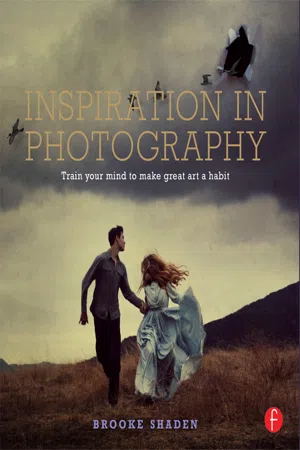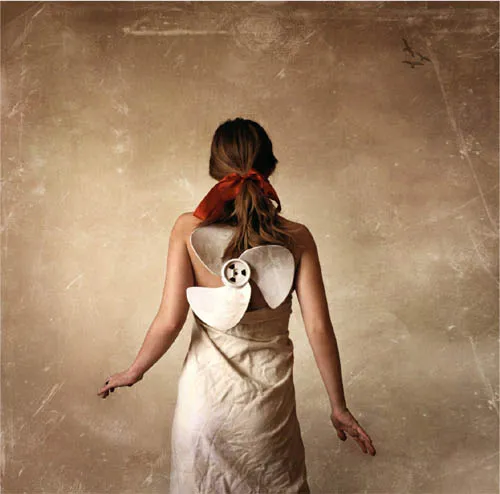![]()
1 THE PHILOSOPHY
PERSONAL HISTORY
Some of my most vivid childhood memories are of being perched high up in a tree in my garden; bees made hives in the tree, which made the trip up all the more terrifying—and all the more exhilarating. I loved climbing trees and taking in the view from above, perhaps because it made me feel like an adventurer. Being in a space that was out of the ordinary allowed my imagination to be set free. From those days to these, I still have a love for all things imaginative.
Growing up in Lancaster, Pennsylvania in the USA gave me many freedoms and advantages, not least of which was being able to immerse myself in truly beautiful scenery. When I found myself at college in Philadelphia—my first time living in a city—I continually longed for country life and even missed the smell of manure from the farms near my home. It was my first time being away from the landscapes I grew up loving, but luckily my mind never entirely left. I found comfort in my imagination and being able to find new ways of portraying my visions. That experience was the first I had in learning to trust myself to know what I like best. Being able to identify what makes us happy is the first step toward finding inspiration, and it was through learning about myself that I learned how to harness my inspiration to work for me.
In so many ways, I have never left that treetop by my childhood home, and I’ve never wanted to. I find solace in being able to find inspiration all around me. My family jokes about the “Brooke face,” which is the lost-in-space stare I get when I’m thinking; I’m usually daydreaming about all the amazing possibilities that I could create. There is nothing more fulfilling to me than retreating within myself and emerging with an idea so powerful that it shakes me to my core.
I always had an idea that growing older meant growing up, and so I expected to one day feel the pressures of adulthood squeeze my creativity. When that day never came, I realized that I had a decision to make: either to embrace the imagination I was given and run with it, or not. The choice was very simple for me. A world without imagination is a world without inspiration—and isn’t inspiration what all those who do creative work strive to achieve?
To be constantly and creatively inspired is a wonderful state to be in, and leads to a happy, bright, and varied life—and one that I want to achieve on a daily basis. I like to consider myself less of a photographer and more of a creator of worlds, a purveyor of magic, or in short, an inventor of inspiration. To be able to find inspiration at the drop of a hat can be the difference between feeling fulfilled and feeling like something vital is missing from our life. Often the difference between the two states is paper thin, and getting from one to the other is as simple as flipping a switch in our mind. The ability to see the world in a different and more inspiring way is something worth aiming for, because if we can achieve this, then our creativity will know no bounds.
THE WHEAT FACTORY (2009)
The Wheat Factory was taken about two months after I first started practicing photography. I was on a road trip across America so that I could settle my life in LA—a far cry from Philadelphia. I was driving through Texas and noticed that all I could see for miles were fields. Deciding to capture that feeling of pure rurality, I pulled over at sunset, wrapped myself in a sheet, and took a picture in a field at the side of a ranch.
UNEARTHED (2008)
Unearthed was one of the first photographs I ever took and is one of the few pictures taken where I began my journey: the suburbs of Philadelphia. I went on a hike, found this tree, and decided that I had to come back to shoot a picture with it. I wrapped myself in my faithful white sheet again and went to work creating this image that, to me, symbolized a new beginning: a tree being pulled up at the roots to reveal a girl.
HOW I GOT MY START
When I was little I was convinced I was going to be a writer. By the time I graduated high school I was certain I was going to be a filmmaker. By the time I finished college I was sure I was going to be a cinematographer. It was not until I picked up a DSLR for the first time that I really knew I was going to be a professional photographer.
When I graduated from Temple University I had two degrees: filmmaking and English. With these degrees I felt armed to tell stories, and I thought my ticket into Hollywood was to write and direct screenplays in which I was also the cinematographer. After realizing the film I’d made wasn’t quite up to standard, with my dreams of movie stardom crumbling, I turned to photography. I’d never previously thought of photography as something that would appeal to me because I’d always associated it with the documentary aspect of capturing scenes as they truly are. Certainly this is an art in itself, but I was never motivated by reality—I wanted to go beyond that.
The discovery of digital photography came at the perfect moment for me. I was fresh out of school and for the first time I had no restrictions. I had no teachers telling me the rules for the next assignment, or any fear of getting a C minus. This time, I could be my own teacher; in fact, I could be the photographer, creator, model, creative director, cinematographer, and storyteller all in one.
WALLEN (2009)
I love creating dark yet conceptual photographs that make the viewer look twice, even if he or she might not want to. This picture was inspired by the feeling of suffocation, both literal and figurative. It was an interesting concept to portray visually.
PROPELLER (2008)
I took this image in my Philadelphia apartment in the first month of my photographic career. I was interested in the idea of using everyday objects and turning them into pieces of art. I took apart my fan and used the propeller from it as a visual element within the scene that created a flight mechanism, hence the title Propeller. The idea that something is impossible does not exist here, as the character will use any means necessary to fly.
WATER FOUNTAIN (2009)
Taken in the basement of my Philadelphia apartment, I was determined to use every interesting object or setting I could find to enhance my photography. I am a portrait photographer through and through, so using a subject within interesting surroundings is what I find exciting. I put myself in the sink in Water Fountain and decided to have the water running to add tension to the image.
My first photographs were self-portraits taken in my tiny city apartment. I began to use photography in unconventional ways. For example, I began compositing images, at first purely because my apartment was too small to take a picture of my whole body (imagine a Nikon D80 with a mounted 70mm lens in a very tight space). I would take a picture of my upper body and then a picture of my lower body, and stitch those pictures together in Photoshop to give the impression that my apartment was bigger than it was.
From day one I was unconcerned with what the current preoccupation in photography was or even how photographers had worked in the past. I was focused on creating whatever imaginative visions I had in my mind. My approach to photography was simple: if someone else had figured this out, then I could too. I started experimenting with my camera and cheap 200W lightbulbs wrapped in Ikea paper lanterns, and then worked with the results in Photoshop. My techniques were simple but effective, and I’ve never looked back.
Photography became something that fulfilled me in every possible way, though I realized very quickly that fulfilment did not come from clicking the shutter, but from the inspiration I felt. Being able to continually access my imagination—and find inspiration for each new image I created—was truly magical.
MY PHILOSOPHY
My ultimate goal is to be inspired from within—whether it’s in photography, creativity, or life in general. Everyone relates to the world in a unique way, and that perspective can be used to not only understand what makes us tick, but also to figure out how we personally handle inspiration. It is easy to look at someone else’s work and feel inspired by it, but all too often this turns into a crutch for finding inspiration—the ideal is to be able to find it within. If we rely too much on outside sources of inspiration such as the work of other photographers, it is not uncommon for our own work to come to resemble too much the inspiration we are drawing from.
My goal is to avoid this problem completely. When I started photography, I had only myself to answer to; this can be a truly liberating experience or a very nerve-wracking one. We are, after all, our own worst critics, and I realized that I had a choice to make. Either I could do what would make me money fast, so that I could afford a better apartment and live comfortably, or I could do what made me happy. I chose to do what made me happy, and also determined that one day it would make me money.
When I first picked up my camera I did not trawl the internet for external inspiration or figure out what might sell best. Instead, I asked myself one very important, yet simple question—what makes me happy? I answered this question very honestly; after all, no one was watching. The answer was simple in theory, but not in execution. I wanted to create dark yet beautiful imagery. ...






